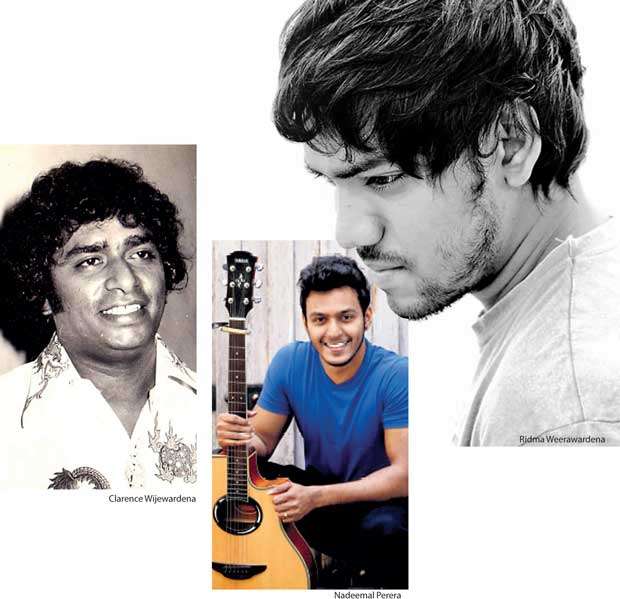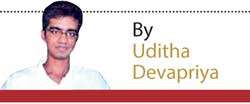Reply To:
Name - Reply Comment
Last Updated : 2024-04-26 10:47:00

 The young of today are caught up, I think, in a curious contradiction. They want to rebel, to let the world know they are not satisfied, but they also want to hide behind a certain welter of security. Their heroes are the singers and the actors who adorn the recent popular culture: heroes shirked as outsiders, who indulge in the cosmetics of rebellion with the privilege of returning to a more secure life once their rebelliousness is done away with. The urban youth, in particular, are transfixed by this fusion of opposites – security and rebellion – and they shape their preferences in the arts based on their preference for that sort of fusion. (They want to have the cake and eat it too, in other words). A long way from home, but still near that home, the young are confused. Not that they need a guide. But they seem to be lost. And they seem to revel in the fact that they are.
The young of today are caught up, I think, in a curious contradiction. They want to rebel, to let the world know they are not satisfied, but they also want to hide behind a certain welter of security. Their heroes are the singers and the actors who adorn the recent popular culture: heroes shirked as outsiders, who indulge in the cosmetics of rebellion with the privilege of returning to a more secure life once their rebelliousness is done away with. The urban youth, in particular, are transfixed by this fusion of opposites – security and rebellion – and they shape their preferences in the arts based on their preference for that sort of fusion. (They want to have the cake and eat it too, in other words). A long way from home, but still near that home, the young are confused. Not that they need a guide. But they seem to be lost. And they seem to revel in the fact that they are.
It’s probably not a coincidence that the art form that appeals to these youngsters and teenagers the most is music, because music, with or without accompanying visuals, is the one art form that depends for its endurance on the doing away of a barrier between the artist and his or her audience. The tastes of the latter are at the outset the tastes of the former; there’s no effort made at mediating the consciousness of either group to equalize it to that of the other. For that reason, the milieu that the artist – in real life or in his work – belongs to happens to be the same milieu that his or her fan base comes from, and moreover revels in. Those who vouch for, and adore, Sanuka Wickramasinghe and Nadeemal Perera and Ridma Weerawardena don’t take to Chamara Weerasinghe, for instance, because Chamara isn’t “sophisticated” enough for their elegant, urbane tastes.
Sanuka and Nadeemal and, to a certain extent, Ridma are exponents of a specific variety of Sinhala music. It’s the sort that thrives on youth and sophistication: the careful inflections, the precise accents, necessitate a balancing act between the urbanness of their fan base and the Sri Lankan-ness of their other listeners. Largely secular, cosmopolitan, and cut off from the wellsprings of our traditional art forms, their most ardent fans affirm a musical idiom that is closer to the city. And because the city flourishes through a contrapuntal mixture of rebellion and conformity, these three vocalists appeal, not to adolescent dreams, but to the rift between those dreams and the lives that the adolescents in the city have to put up with. One night stands, romances that never take off, first romances: these experiences can be articulated only by those who have the luxury of an alternative life, and this life Sanuka and Nadeemal celebrate in song after song.
For some reason, beat bands are, in Sri Lanka, considered populist. With a few exceptions, such bands have been associated with cheap, easy music, having very little instrumentation and virtually no acoustics. Even the vocalists who opt to sing with these bands are judged harshly and put down. Such an attitude, of judging them on how sophisticated their voices are, betrays a set of insidious class prejudices: you don’t like Chamara because he isn’t “cool” enough, because he isn’t equipped with the symbols of chic sophistication (the slick, combed hair; the alienating, imposing sunglasses; the casual, reluctant smile) that Bathiya, Santhush, and Sanuka project. With his idiosyncratic and sun-baked face, Chamara is a hero to the downtrodden and the dispossessed, who listen to him while travelling in the bus and who don’t have the money to repair their own broken radios (and lives) back home. Musically, those who dote on Sanuka et al are sophisticated, or at least THINK they’re sophisticated (when they are not).
The same can be said of Saman Lenin, whose popularity is, however, different to Chamara’s just as Chamara’s popularity is different to Sanuka’s. The music that Lenin affirms is the music of the past, which comes up from the wellsprings of the Sinhala language, i.e. the rural and spoken variant. Chamara Weerasinghe is not a purist like this: he is willing and he has made compromises over the years to win at least a section of the pop audience that Sanuka has monopolized, even those who don’t usually take to beat bands that easily. Lenin doesn’t really make compromises like that. He has been singing of the village and he returns to the village in song after song; music videos are at best expendable to him, and if he will resort to it, it will be the type of video we see every day on television (which focuses on the vocalist, and spares little time for the unfolding of a narrative).
Careful inflections, precise accents, necessitate a balancing act between the urbanness of their fan base and the Sri Lankan-ness of their other listeners
Baila began with the Kaffirs, i.e. their dialects and dances. It found its 20th century indigenous proponent with Wally Bastian, right before we attained independence (in the forties). From Bastian and his successor, Desmond Kelly, we come to M. S. Fernando and Anton Jones, both of whom appealed to a different milieu: more vernacular, more home-grown, they were despised by the upper and middle classes, who shirked them and pandered to the likes of Clarence and The Moonstones and Calypso. From Fernando and Jones, we come to Dalreen and Desmond Fernando and Mariazelle Goonetilake, who more or less returned to the classist exuberance that Bastian and Kelly had revelled in. Like Clarence, they thrived on a separation of the householder from the servant (a separation which M. S. and Anton refused to make or continue, since they sang almost completely about the hard done by petty bourgeoisie, along with the urban proletariat), and from them, we come to Paul Fernando, Christopher Paul, and Punsiri Soyza, all three of whom hailed from Moratuwa and all three of whom took baila to the milieu that M. S. and Anton had celebrated before.
Perhaps it’s pertinent to note that even a vocalist like the late (and forever unequaled) W. D. Amaradeva evoked different responses from different audiences. Amaradeva’s early period, as some have observed, comprised of compositions and songs which tried to keep up with the experiments that Sunil Shantha was conducting. His second period, after his return from Shantiniketan and before he fused the raghadari tradition with the Sinhala quatrain, saw him dabble in calypso and baila: these songs (“Atha Gaw Ganan Durin”and “Pipi Pipi” being two of them, the former written by Mahagama Sekara) are the songs we have that remind us that the man came from a largely coastal environment, which reacted, not to the profundity of Sinhala poetry, but the saltiness of a genre that brought their community together, in dance and drink and revelry.
In abandoning this phase for the phase in which he gave out “Kumariyaka Pa Salamba Saluna” and “Ma Mala Pasu” and so on, Amaradeva, I think, was inadvertently appealing to the same milieu which had helped prop up the cultural revolution of 1956: not the peasantry, who reacted with mixed feelings to the (supposedly) Sinhalised movies of Lester James Peries and ballets of Chitrasena, but the petty bourgeoisie. The children of this petty bourgeoisie grew up listening to Amaradeva on the one hand and Clarence on the other; it was a bifurcation of tastes within the same milieu which ignored if not marginalised the efforts of Lionel Ranwala, and Piyasiri Wijeratne (if you search for “Badde Pura” on YouTube, almost all the search results will make you think that it was sung by Amitha Wedisinghe only; Piyasiri is forgotten today because he was forgotten in his time), to take our music beyond the raag and Western melody.
Going by this, the grandchildren, of the children who were responsible for 1956, have evolved to appreciate Sanuka and Nadeemal and Ridma over Chamara and Saman Lenin because their tastes are somewhat genetic, conditioned at the outset by the environment they are in and the families they are born to. In one sense, I think such a separation, mostly hereditary, is to be welcomed, because it helps us understand the complex array of sensibilities which goes into the shaping of vocalists and musical forms. On the other hand, if we continue to make this an excuse for ignoring the musical Other, we will only be poorer. The true aesthete, I’ve always felt, sheds class-bound sensibilities. The tragedy is that we are not a nation of aesthetes. We are a nation of human beings. And we are flawed.
UDAKDEV1@GMAIL.COM

Add comment
Comments will be edited (grammar, spelling and slang) and authorized at the discretion of Daily Mirror online. The website also has the right not to publish selected comments.
Reply To:
Name - Reply Comment
US authorities are currently reviewing the manifest of every cargo aboard MV
On March 26, a couple arriving from Thailand was arrested with 88 live animal
According to villagers from Naula-Moragolla out of 105 families 80 can afford
Is the situation in Sri Lanka so grim that locals harbour hope that they coul